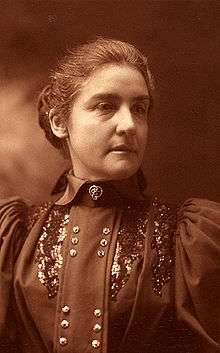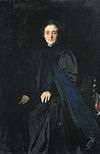M. Carey Thomas
| Martha Carey Thomas | |
|---|---|
 Martha Carey Thomas | |
| Born |
January 2, 1857 Baltimore, Maryland |
| Died |
December 2, 1935 (aged 78) Philadelphia, Pennsylvania |
| Nationality | American |
| Other names | Carey Thomas |
| Known for | Educator, suffragist, and second President of Bryn Mawr College |
Martha Carey Thomas (January 2, 1857 – December 2, 1935) was an American educator, suffragist, linguist, and second President of Bryn Mawr College.
Biography
Early life
Carey Thomas, as she preferred to be called later in life (she was known as Minnie to her family as a child), was born in Baltimore, Maryland on January 2, 1857. She was the daughter of James Carey Thomas and Mary Whitall Thomas. She was conceived "in full daylight," because her father, a doctor, thought this would diminish the chance of his wife miscarrying.[1]:3 Her family included many prominent Quakers, including her uncle and aunt Robert Pearsall Smith and Hannah Whitall Smith, and her cousins Alys Pearsall Smith (first wife of Bertrand Russell) and Mary Smith Berenson Costelloe (who married Bernard Berenson).
In 1864, when Carey Thomas was just seven years old, she was severely burned while trying to help her cook, Eliza, prepare lunch. Thomas's frock caught on fire and the young girl was engulfed in flames, which were shortly thereafter extinguished by her mother. Her recovery was long and arduous, a time during which her mother cared for her intently. Growing up, Thomas was strongly influenced by the staunch feminism of her mother and her mother's sister Hannah Whitall Smith, who became a prominent preacher. Her father, a physician, was not completely happy with feminist ideas, but his daughter was fiercely independent, and he supported her in all of her independent endeavors. Though both her parents were orthodox members of the Society of Friends, Thomas' education and European travel led her to question those beliefs and develop a love for music and theater, both of which were forbidden to Orthodox Quakers. This religious questioning led to friction with her mother.
Thomas initially attended a Society of Friends school in Baltimore. Minnie had a strong childhood relationship with her cousin, Frank Smith, Hannah Smith's son. The two were almost inseparable until Frank's sudden death in 1872. His death deeply depressed Minnie, and moved her parents to send her to the Howland Institute. Minnie transferred with her cousin, Bessie, to the Howland Institute, a Quaker boarding school near Ithaca, New York, in October, 1872. While at Howland, Minnie decided to dress as a man in the school's opera, which made her mother very upset, for it was "repugnant to her taste." It was here that Miss Slocum, a teacher at Howland, influenced her to study education, rather than medicine. Thomas hoped to enter Cornell University to pursue further education, but met with her father's objections. After a great deal of pleading from both Thomas and her mother, her father relented.[2]
Thomas went to Sage College, a women's school at Cornell University, in September, 1875, where she formally changed her name to Carey from Minnie. She graduated from Cornell University in 1877. Cornell offered her both the position of professor of literature and dean of Sage College, but she did not consider either.[1] She did graduate work in Greek at Johns Hopkins University, but withdrew because she was not permitted to attend classes.[2] She did further graduate work at the University of Leipzig, but that university did not grant degrees to women. She then went to the University of Zurich and earned a Ph.D. in linguistics, summa cum laude, in 1882 for her dissertation, which was a philological analysis of Sir Gawain and the Green Knight. This dissertation continued to be highly regarded by specialists eighty years later.[2] She was the first woman and the first foreigner to receive such a doctorate from the university.[2] She then spent some time in Paris, where she attended lectures by Gaston Paris at the Sorbonne, and then went back home to the United States. Thomas did not pursue her degree out of love for her academic work, but rather out of a desire to show Americans that women had the same intellectual capacity as men.[2]
At Bryn Mawr
In 1882, Thomas wrote a letter to the trustees of Bryn Mawr College, requesting that she be made president of the university. She was not granted the position, however, as the trustees were concerned about her relative youth and lack of experience.[2] Instead, Thomas entered in 1884 as the dean of the college and chair of English. Despite not receiving her desired role at Bryn Mawr, Thomas was active in the college's administration, working closely with then President James Rhoads. According to the biographical dictionary Notable American Women: 1607–1950, by 1892 she was "acting president in all but name".[2]
At the end of April 1884 Thomas went with the encouragement of President Rhoads to tour other colleges in the area to become familiar with them in order to bring ideas back to Bryn Mawr. She started her tour at Vassar, then she went on to Smith College, Wellesley, and ended her tour at Radcliffe (or the Harvard Annex as it was still called at the time).[3]
In 1885 Thomas, together with Mary Garrett, Mamie Gwinn, Elizabeth King, and Julia Rogers, founded The Bryn Mawr School in Baltimore Maryland. The school would produce well-educated young women who met the very high entrance standards of Bryn Mawr College.
In 1894, President Rhoads died,[4] and Thomas was narrowly elected to succeed him on September 1, 1894. Out of respect for President Rhoads's recent death, Thomas was not given any ceremony. She was president until 1922 and remained as Dean until 1908. During her tenure as president, Thomas' primary concern was upholding the highest standards of admissions and academic rigor. The entrance examinations for the college were made as difficult as those at Harvard University, and pupils could not gain admission by certificate. For the academic curriculum, Thomas emulated the "group system" of Johns Hopkins, in which students were required to take parallel courses in a logical sequence. Students could not freely choose electives. There were also other requirements, including a foreign language requirement that culminated in a sight translation examination proctored by Thomas herself. Overall, the academic curriculum at Bryn Mawr under Thomas shunned liberal arts education, preferring more traditional topics such as Greek, Latin, and mathematics.[2] Thomas was also instrumental in bringing several new buildings to the College, which introduced collegiate Gothic architecture to the United States.
In 1908, she became the first president of the National College Women's Equal Suffrage League. She was also a leading member of the National American Woman Suffrage Association. After 1920 she advocated the policies of the National Woman's Party. She was one of the early promoters of an equal rights amendment to the U.S. Constitution.
For many years Thomas maintained an intimate relationship with long-time friend, Mamie Gwinn.[5] Thomas and Gwinn lived together at Bryn Mawr College in a small cottage that came to be known as "the Deanery".[6] When Gwinn left Thomas in 1904 to marry (a love triangle fictionalized in Gertrude Stein's Fernhurst) Alfred Hodder, a fellow Professor of English at Bryn Mawr College,[7] Thomas pursued a relationship with Mary Elizabeth Garrett.[5] Thomas shared her campus home, the Deanery, with Garrett and together they endeavored to grow Bryn Mawr's resources. Upon her death, Garrett, who had been prominent in suffrage work and a benefactor of Bryn Mawr, left to President Thomas "a sum which would, in 1994, be close to $15,000,000."[1]:424 to be disposed of as she saw fit. M. Carey Thomas had firm views on marriage, and in a letter to her mother she described it as a "Loss of freedom, poverty, and a personal subjection for which I see absolutely no compensation." [1]:173
Later life and death
Thomas retired in 1922, at age sixty-five. She left the college in the capable hands of Marion Edwards Park, who had served as a dean at both Simmons and Radcliffe Colleges. The Bryn Mawr Summer School for Women Workers in Industry, which was founded at Carey's behest in 1921, was a sort of "grand finale" bookending Thomas' legacy as an earlier shaper of the college.[1]:40 Mary Garrett left a considerable fortune to Thomas, who spent the last two decades of her life traveling the world in luxury, including trips to India, the Sahara, and France. Thomas died at Philadelphia, Pennsylvania, on December 2, 1935 of a coronary occlusion. She had returned to the city to address Bryn Mawr College on the fiftieth anniversary of its founding. Her ashes were scattered on the Bryn Mawr College campus in the cloisters of the Thomas Library.[2]
Gallery
 1899 portrait of M. Carey Thomas by John Singer Sargent.
1899 portrait of M. Carey Thomas by John Singer Sargent.
References
- 1 2 3 4 5 Horowitz, Helen (1994). The Power and Passion of M. Carey Thomas. New York: Knopf. ISBN 0-252-06811-4.
- 1 2 3 4 5 6 7 8 9 "THOMAS, Martha Carey (Jan. 2, 1857 – Dec. 2, 1935): Educator and Feminist". Notable American Women: 1607–1950. Harvard University Press. 1971. Retrieved 2010-04-04.
- ↑ Finch, Edith (1947). Carey Thomas of Bryn Mawr. New York & London: Harper & Brothers. pp. 138–144.
- ↑ "James E. Rhoads, 1885–1894". Bryn Mawr College. Retrieved 2014-03-03.
- 1 2 Faderman, Lillian (1991). Odd girls and twilight lovers : a history of lesbian life in twentieth-century America ([4. Aufl.] ed.). New York: Columbia University Press. p. 30. ISBN 978-0231074889.
- ↑ Horowitz, Helen (1994). The Power and Passion of M. Carey Thomas. New York: Alfred A. Knopf. pp. 172, 202–203.
- ↑ Horowitz. The Power and Passion of M. Carey Thomas. pp. 211–212, 278–286, 359.
External links
| Library resources about M. Carey Thomas |
| By M. Carey Thomas |
|---|
| Wikimedia Commons has media related to M. Carey Thomas. |
- Finding Aid to the M. Carey Thomas Papers, Bryn Mawr College Library
- M. Carey Thomas at www.brynmawr.edu
- The Very Best Woman's College There Is at www.brynmawr.edu
- Find-A-Grave biography (picture)
- Photographs of M. Carey Thomas Bryn Mawr College Photo Archives